A Modified Shape Model Incorporating Continuous Accumulated Growing Degree Days for Phenology Detection of Early Rice
Abstract
1. Introduction
2. Materials and Methods
2.1. Materials
2.1.1. Study Area
2.1.2. Remote Sensing Data
2.2. Methods
2.2.1. Calendar Day-Based Shape Model
2.2.2. The Continuous Accumulated Growing Degree Days
- (1)
- Firstly, find the time with the highest temperature in the middle period of the 24-h sequence, defined as the center point O.
- (2)
- Secondly, find the turning points A and B which have an equal distance from point O in 1/4 of a cycle. Given the lowest temperature in the 24-h sequence is Tmin and the temperature value of center point O as TO, assign the average value of Tmin and TO to both A and B.
- (3)
- With the determined three key points A, B and O, a sine curve can be obtained to represent the 24-h temperatures.
2.2.3. Supplement of Continuous Accumulated Growing Degree Days Model
3. Results and Discussions
3.1. Phenological Extraction
3.2. Verification of Rationality of Extracting Phenological Period by CAGDD-SM Method
4. Conclusions
Supplementary Materials
Author Contributions
Funding
Data Availability Statement
Acknowledgments
Conflicts of Interest
References
- Körner, C.; Basler, D. Phenology Under Global Warming. Science 2010, 327, 1461–1462. [Google Scholar] [CrossRef] [PubMed]
- Zwart, S.J.; Bastiaanssen, W.G.M. Review of measured crop water productivity values for irrigated wheat, rice, cotton and maize. Agric. Water Manag. 2004, 69, 115–133. [Google Scholar] [CrossRef]
- Pimstein, A.; Eitel, J.; Long, D.; Mufradi, I.; Karnieli, A.; Bonfil, D. A spectral index to monitor the head-emergence of wheat in semi-arid conditions. Field Crop. Res. 2009, 111, 218–225. [Google Scholar] [CrossRef]
- Xiao, D.P.; Tao, F.L.; Liu, Y.J.; Shi, W.J.; Wang, M.; Liu, F.S.; Zhang, S.A.; Zhu, Z. Observed changes in winter wheat phenology in the North China Plain for 1981–2009. Int. J. Biometeorol. 2013, 57, 275–285. [Google Scholar] [CrossRef]
- Akhtar, F.; Awan, U.K.; Tischbein, B.; Liaqat, U.W. A phenology based geo-informatics approach to map land use and land cover (2003–2013) by spatial segregation of large heterogenic river basins. Appl. Geogr. 2010, 88, 48–61. [Google Scholar] [CrossRef]
- Liu, L.L.; Zhang, X.Y.; Yu, Y.Y.; Gao, F.; Yang, Z.W. Real-Time Monitoring of Crop Phenology in the Midwestern United States Using VIIRS Observations. Remote Sens. 2018, 10, 1540. [Google Scholar] [CrossRef]
- Rembold, F.; Meroni, M.; Urbano, F.; Csak, G.; Kerdiles, H.; Perez-Hoyos, A.; Lemoine, G.; Leo, O.; Negre, T. ASAP: A new global early warning system to detect anomaly hot spots of agricultural production for food security analysis. Agric. Syst. 2019, 168, 247–257. [Google Scholar] [CrossRef]
- Skawsang, S.; Nagai, M.; Tripathi, N.K.; Soni, P. Predicting Rice Pest Population Occurrence with Satellite-Derived Crop Phenology, Ground Meteorological Observation, and Machine Learning: A Case Study for the Central Plain of Thailand. Appl. Sci. 2019, 9, 4846. [Google Scholar] [CrossRef]
- Funk, C.; Budde, M.E. Phenologically-tuned MODIS NDVI-based production anomaly estimates for Zimbabwe. Remote Sens. Environ. 2009, 113, 115–125. [Google Scholar] [CrossRef]
- Bolton, D.K.; Friedl, M.A. Forecasting crop yield using remotely sensed vegetation indices and crop phenology metrics. Agric. For. Meteorol. 2013, 173, 74–84. [Google Scholar] [CrossRef]
- Sakamoto, T.; Gitelson, A.A.; Arkebauer, T.J. MODIS-based corn grain yield estimation model incorporating crop phenology information. Remote Sens. Environ. 2013, 131, 215–231. [Google Scholar] [CrossRef]
- Magney, T.; Eitel, J.; Huggins, D.; Vierling, L. Proximal NDVI derived phenology improves in-season predictions of wheat quantity and quality. Agric. For. Meteorol. 2016, 217, 46–60. [Google Scholar] [CrossRef]
- Gao, F.; Anderson, M.C.; Zhang, X.Y.; Yang, Z.W.; Alfieri, J.G.; Kustas, W.P.; Mueller, R.; Johnson, D.M.; Prueger, J.H. Toward mapping crop progress at field scales through fusion of Landsat and MODIS imagery. Remote Sens. Environ. 2017, 188, 9–25. [Google Scholar] [CrossRef]
- Kang, Y.H.; Özdoğan, M. Field-level crop yield mapping with Landsat using a hierarchical data assimilation approach. Remote Sens. Environ. 2019, 228, 144–163. [Google Scholar] [CrossRef]
- Mateo-Sanchis, A.; Piles, M.; Muñoz-Marí, J.; Adsuara, J.E.; Pérez-Suay, A. Synergistic integration of optical and microwave satellite data for crop yield estimation. Remote Sens. Environ. 2019, 234, 111460. [Google Scholar] [CrossRef]
- Zeng, L.L.; Wardlow, B.; Xiang, D.; Hu, S.; Li, D. A review of vegetation phenological metrics extraction using time-series, multispectral satellite data. Remote Sens. Environ. 2020, 237, 111511. [Google Scholar] [CrossRef]
- Mayer, A. Phenology and citizen science. Bioscience 2010, 60, 172–175. [Google Scholar] [CrossRef]
- Dai, J.; Xu, Y.; Wang, H.; Alatalo, J.; Tao, Z. Variations in the temperature sensitivity of spring leaf phenology from 1978 to 2014 in Mudanjiang, China. Int. J. Biometeorol. 2017, 63, 569–577. [Google Scholar] [CrossRef]
- Yan, D.; Zhang, X.Y.; Nagai, S.; Yu, Y.Y.; Akitsu, T.; Nasahara, K.N.; Ide, R.; Maeda, T. Evaluating land surface phenology from the Advanced Himawari Imager using observations from MODIS and the Phenological Eyes Network. Int. J. Appl. Earth Obs. 2019, 79, 71–83. [Google Scholar] [CrossRef]
- Vrieling, A.; Meroni, M.; Darvishzadeh, R.; Skidmore, A.; Wang, T.; Zurita-Milla, R.; Oosterbeek, K.; O’Connor, B.; Paganini, M. Vegetation phenology from Sentinel-2 and field cameras for a Dutch barrier island. Remote Sens. Environ. 2018, 215, 517–529. [Google Scholar] [CrossRef]
- Berra, E.F.; Gaulton, R.; Barr, S. Assessing spring phenology of a temperate woodland: A multiscale comparison of ground, unmanned aerial vehicle and Landsat satellite observations. Remote Sens. Environ. 2019, 223, 229–242. [Google Scholar] [CrossRef]
- Brown, M.; de Beurs, K.; Marshall, M. Global phenological response to climate change in crop areas using satellite remote sensing of vegetation, humidity and temperature over 26 years. Remote Sens. Environ. 2012, 126, 174–183. [Google Scholar] [CrossRef]
- Atzberger, C. Advances in Remote Sensing of Agriculture: Context Description, Existing Operational Monitoring Systems and Major Information Needs. Remote Sens. 2013, 5, 949–981. [Google Scholar] [CrossRef]
- Chen, F.X.; Liu, Z.J.; Zhong, H.M.; Wang, S.S. Exploring the Applicability and Scaling Effects of Satellite-Observed Spring and Autumn Phenology in Complex Terrain Regions Using Four Different Spatial Resolution Products. Remote Sens. 2021, 13, 4582. [Google Scholar] [CrossRef]
- Babcock, C.; Finley, A.O.; Looker, N. A Bayesian model to estimate land surface phenology parameters with harmonized Landsat 8 and Sentinel-2 images. Remote Sens. Environ. 2021, 261, 112471. [Google Scholar] [CrossRef]
- Ishigooka, Y.; Kuwagata, T.; Goto, S.; Toritani, H.; Ohno, H.; Urano, S. Modeling of continental-scale crop water requirement and available water resources. Paddy Water Environ. 2008, 6, 55–71. [Google Scholar] [CrossRef]
- Zhang, X.; Goldberg, M.D. Monitoring fall foliage coloration dynamics using time-series satellite data. Remote Sens. Environ. 2011, 115, 382–391. [Google Scholar] [CrossRef]
- Kobayashi, H.; Yunus, A.P.; Nagai, S.; Sugiura, K.; Kim, Y.; Dam, B.V.; Nagano, H.; Zona, D.; Harazono, Y.; Bret-Harte, M.S. Latitudinal gradient of spruce forest understory and tundra phenology in Alaska as observed from satellite and ground-based data. Remote Sens. Environ. 2016, 177, 160–170. [Google Scholar] [CrossRef]
- Reed, B.C.; Brown, J.F.; VanderZee, D.; Loveland, T.R.; Merchant, J.W.; Ohlen, D.O. Measuring phenological variability from satellite imagery. J. Veg Sci. 1994, 5, 703–714. [Google Scholar] [CrossRef]
- Zhang, X.; Friedl, M.; Schaaf, C.; Strahler, A.; Hodges, J.; Gao, F. Monitoring vegetation phenology using MODIS time-series data. Remote Sens. Environ. 2003, 84, 471–475. [Google Scholar] [CrossRef]
- Tateishi, R.; Ebata, M. Analysis of phenological change patterns using 1982–2000 advanced very high resolution radiometer (AVHRR) data. Int. J. Remote Sens. 2004, 25, 2287–2300. [Google Scholar] [CrossRef]
- Sakamoto, T. Refined shape model fitting methods for detecting various types of phenological information on major U.S. crops. ISPRS J. Photogramm. 2018, 138, 176–192. [Google Scholar] [CrossRef]
- Liao, C.H.; Wang, J.F.; Dong, T.F.; Shang, J.L.; Liu, J.G.; Song, Y. Using spatio-temporal fusion of Landsat-8 and MODIS data to derive phenology, biomass and yield estimates for corn and soybean. Sci. Total Environ. 2019, 650, 1707–1721. [Google Scholar] [CrossRef] [PubMed]
- White, M.A.; Thornton, P.E.; Running, S.W. A continental phenology model for monitoring vegetation responses to interannual climatic variability. Glob. Biogeochem. Cycles. 1997, 11, 217–234. [Google Scholar] [CrossRef]
- White, K.; Pontius, J.; Schaberg, P. Remote sensing of spring phenology in northeastern forests: A comparison of methods, field metrics and sources of uncertainty. Remote Sens. Environ. 2014, 148, 97–107. [Google Scholar] [CrossRef]
- Mobasheri, M.R.; Chahardoli, M.; Farajzadeh, M. Introducing PASAVI and PANDVI methods for sugarcane physiological date estimation, using ASTER images. J. Agric. Sci. Technol. 2010, 12, 309–320. [Google Scholar]
- Moulin, S.; Kergoat, L.; Viovy, N.; Dedieu, G. Global-scale assessment of vegetation phenology using NOAA/AVHRR satellite measurements. J. Clim. 1997, 10, 1154–1170. [Google Scholar] [CrossRef]
- Sakamoto, T.; Wardlow, B.; Gitelson, A. A Two-Step Filtering approach for detecting maize and soybean phenology with time-series MODIS data. Remote Sens. Environ. 2010, 114, 2146–2159. [Google Scholar] [CrossRef]
- Xiao, J.; Li, N.; Jiang, H.F. Calculation and Stability of Accumulated Temperatures in the Growing Season of Winter wheat. J. Meteor. Res. Appl. 2010, 31, 65–67. [Google Scholar]
- Jin, Y.; Wong, K.W.; Wu, Z.D.; Qi, D.B.; Wang, R.; Han, F.; Wu, W.F. Relationship between accumulated temperature and quality of paddy. Int. J. Food Prop. 2019, 22, 19–33. [Google Scholar] [CrossRef]
- Chen, T.; Huang, Q.; Gao, D.; Huang, Z.; Zheng, Y.; Li, Y. Accumulated Temperature as an Indicator to Predict the Stabilizing Process in Sewage Sludge Composting. Acta Ecol. Sin. 2002, 22, 911–915. [Google Scholar]
- Zeng, L.L.; Wardlow, B.; Li, D. A hybrid approach for detecting corn and soybean phenology with time-series MODIS data. Remote Sens. Environ. 2016, 181, 237–250. [Google Scholar] [CrossRef]
- Zhou, M.; Ma, X.; Wang, K.; Cheng, T.; Tian, Y.; Wang, J.; Yao, X.; Zhu, Y. Detection of phenology using an improved shape model on time-series vegetation index in wheat. Comput. Electron. Agric. 2020, 173, 105398. [Google Scholar] [CrossRef]
- Watanabe, N. An Improved Method for Computing Heat Accumulation from Daily Maximum and Minimum Temperatures. Appl. Entomol. Zool. 1978, 13, 44–46. [Google Scholar] [CrossRef]
- Myneni, R.B.; Hall, F.G.; Sellers, P.J.; Marshak, A.L. The Interpretation of Spectral Vegetation Indexes. IEEE Trans. Geosci. Remote Sens. 1995, 33, 481–486. [Google Scholar] [CrossRef]
- dela Torre, D.M.G.; Gao, J.; Macinnis-Ng, C. Remote sensing-based estimation of rice yields using various models: A critical review. Geo Spat. Inf. Sci. 2021, 24, 580–603. [Google Scholar] [CrossRef]
- Yang, G.; Huang, K.; Sun, W.W.; Meng, X.C.; Mao, D.H.; Ge, Y. Enhanced mangrove vegetation index based on hyperspectral images for mapping mangrove. ISPRS J. Photogramm. 2022, 189, 236–254. [Google Scholar] [CrossRef]
- Lemos, H.D.; Verstraete, M.M.; Scholes, M. Parametric Models to Characterize the Phenology of the Lowveld Savanna at Skukuza, South Africa. Remote Sens. 2020, 12, 3927. [Google Scholar] [CrossRef]
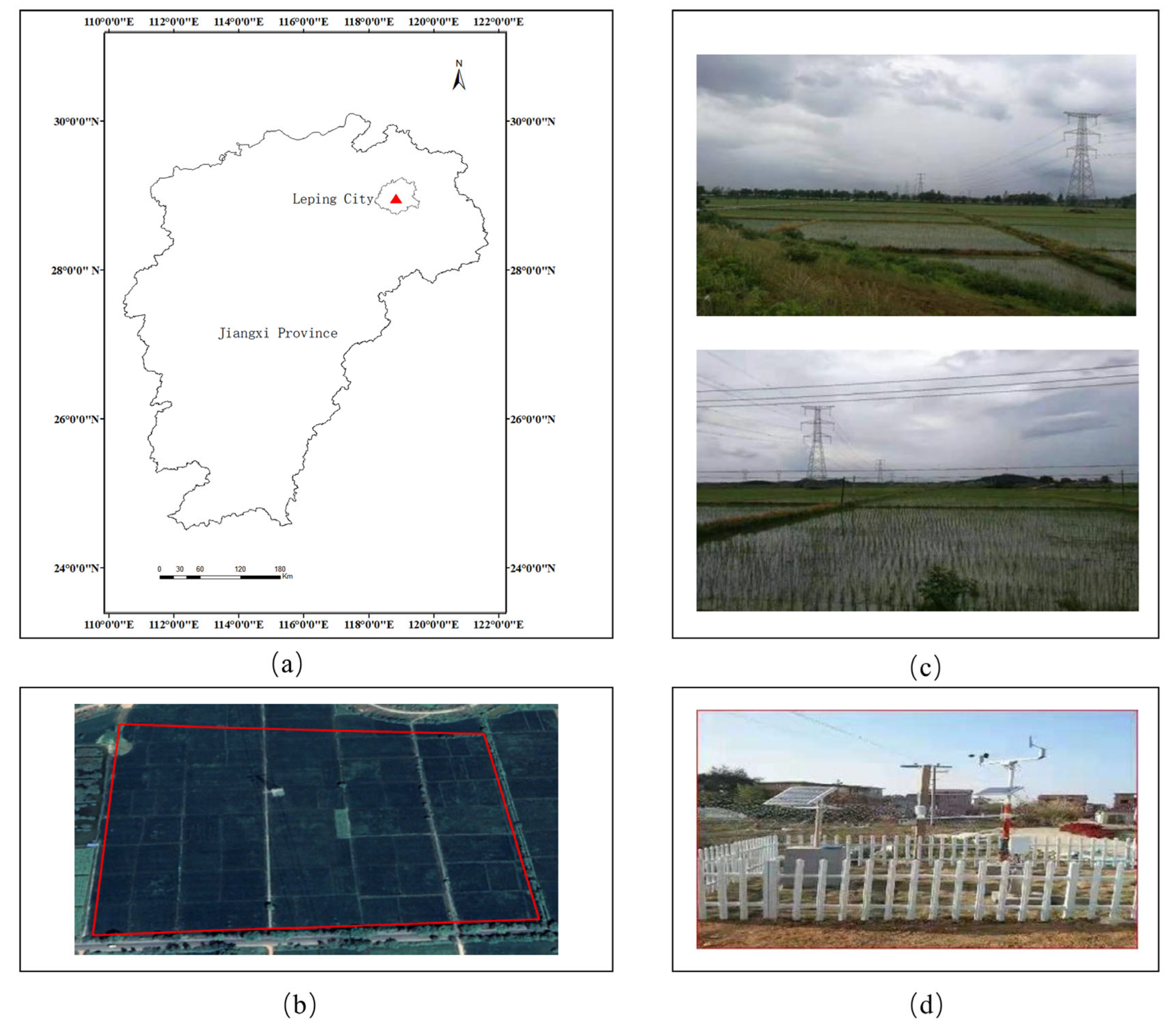

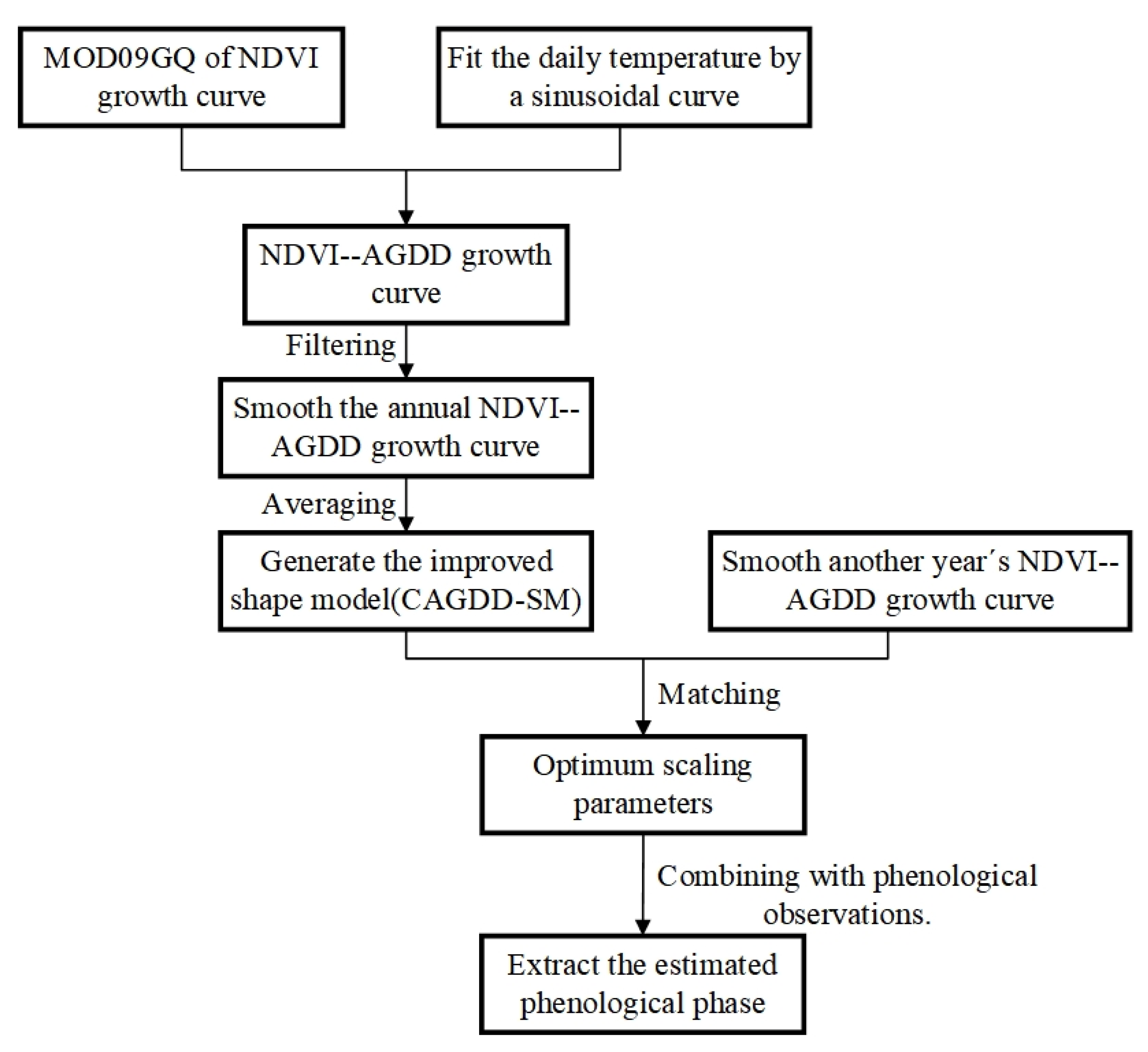
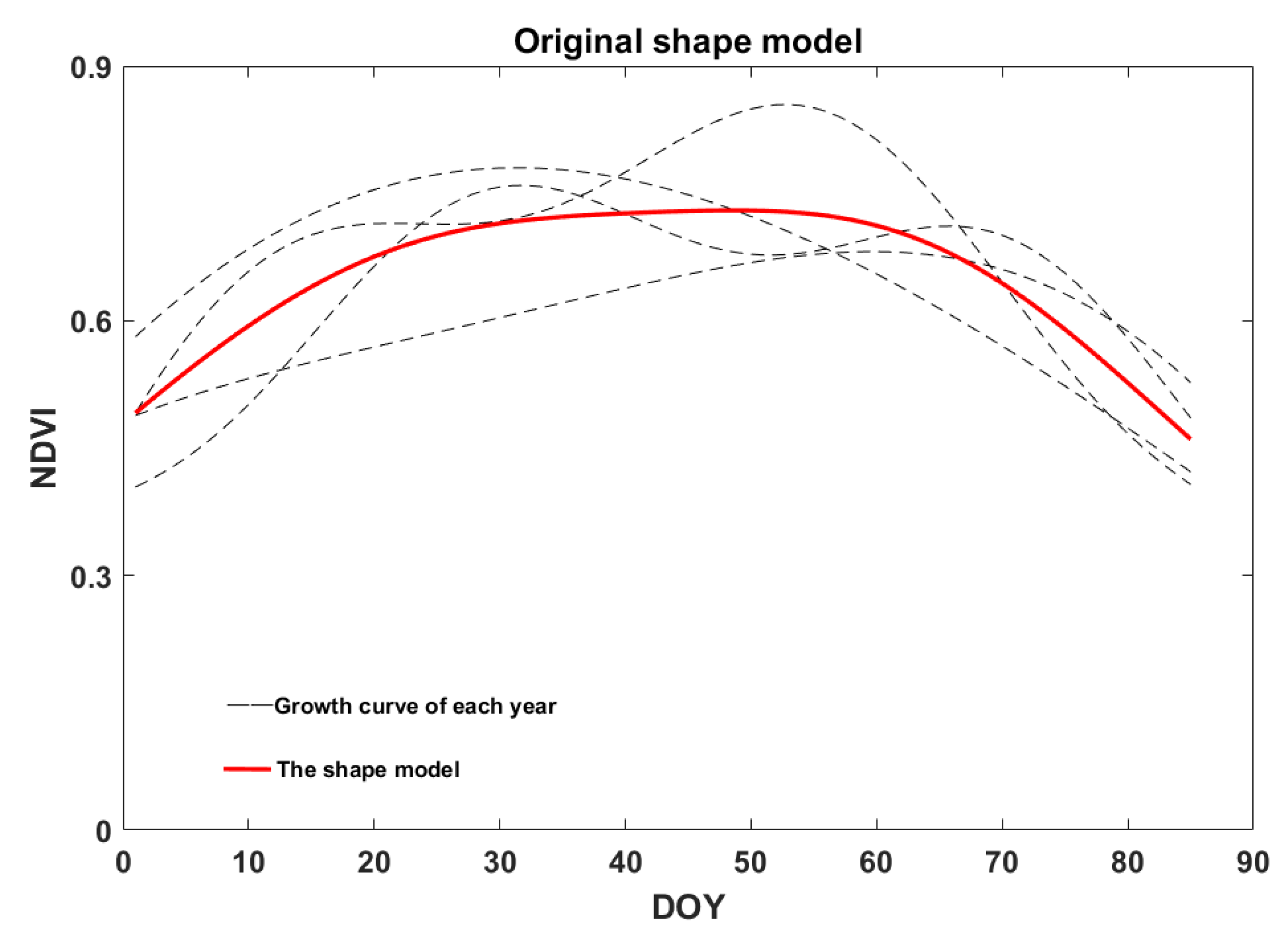
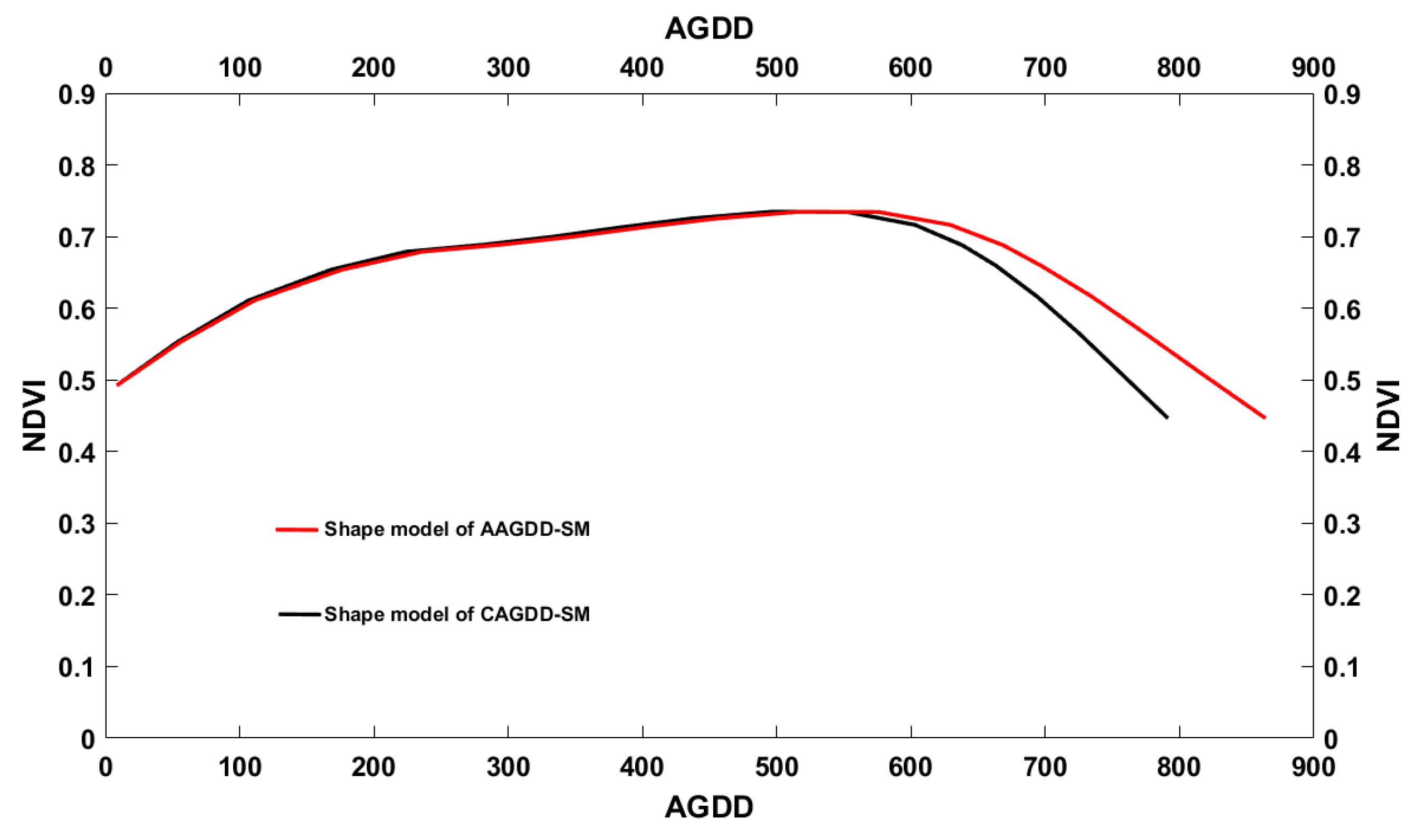
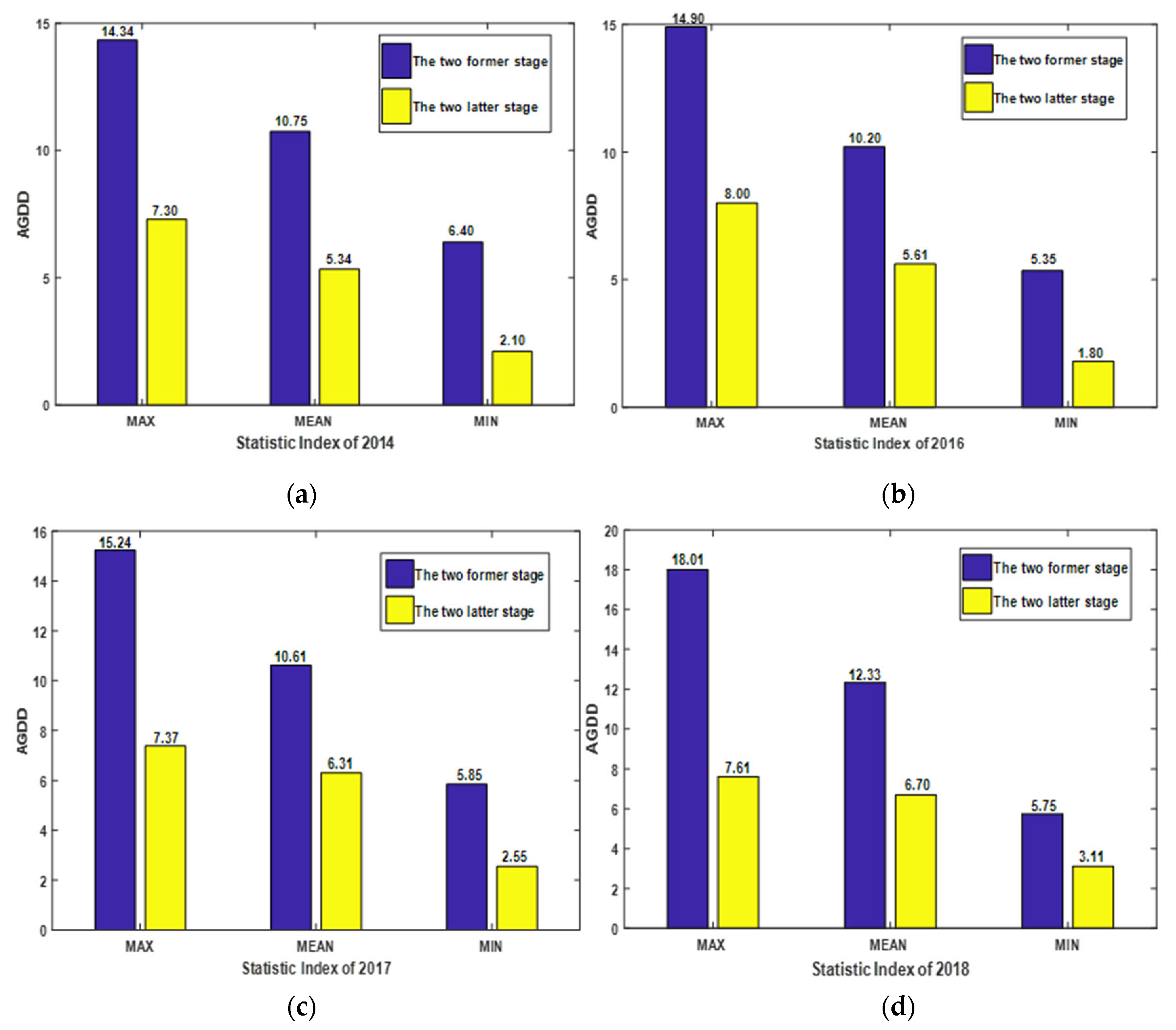

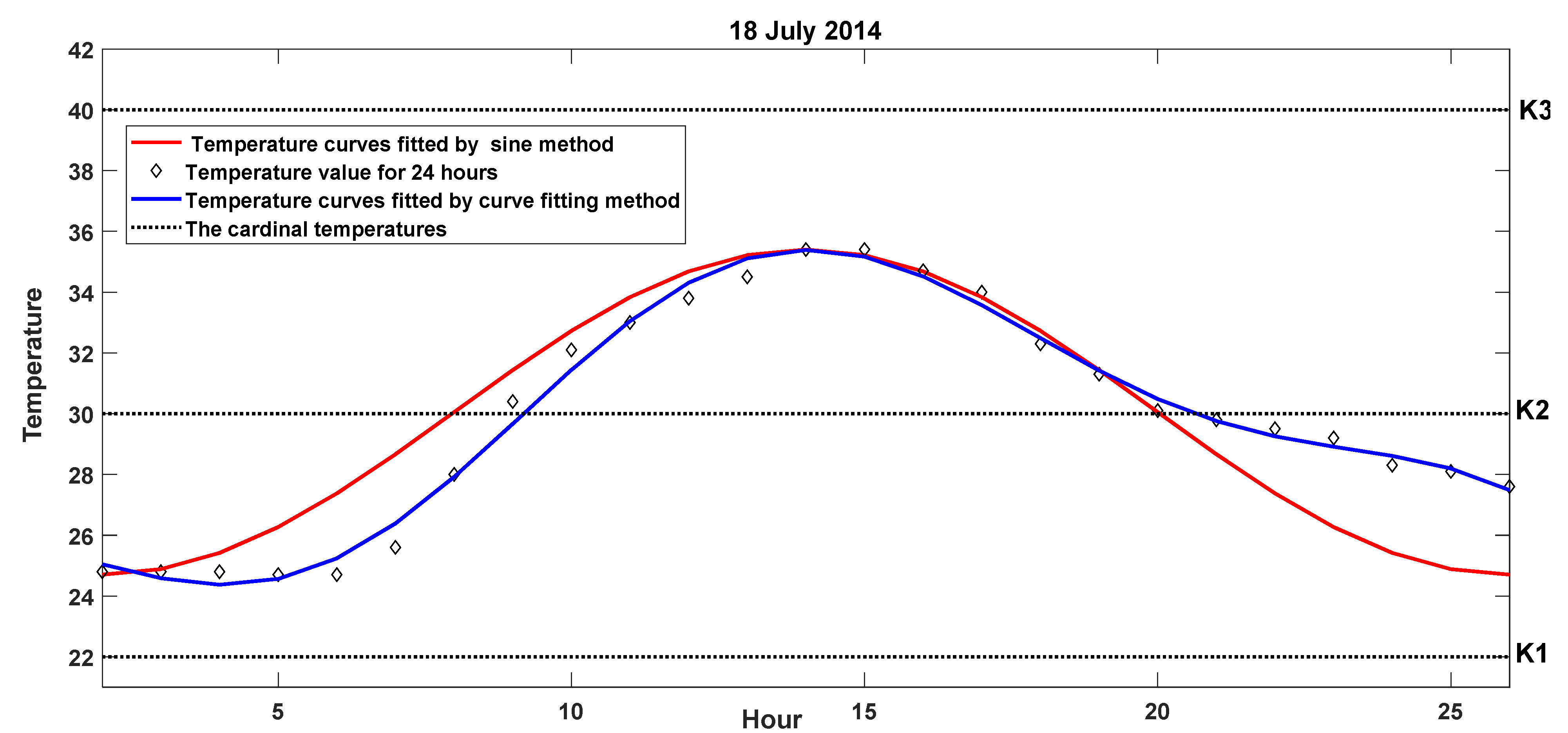
| Phenology Stage | K1 (°C) | K2 (°C) | K3 (°C) |
|---|---|---|---|
| Reviving | 12 | 32 | 42 |
| Tillering | 15 | 32 | 42 |
| Heading | 22 | 30 | 40 |
| Anthesis | 22 | 30 | 40 |
| Phenology Stage | ||
|---|---|---|
| Reviving | 7 | 65.68 |
| Tillering | 28 | 305.38 |
| Heading | 58 | 622.33 |
| Anthesis | 61 | 634.84 |
| Year 2018 | Reviving | Tillering | Heading | Anthesis |
|---|---|---|---|---|
| The estimated AGDD | 133.18 | 336.92 | 606.33 | 616.97 |
| Year 2018 | Day 1 | Day 2 | ... | Day 9 | Day 10 | Day 11 | Day 12 |
|---|---|---|---|---|---|---|---|
| AGDD value | 11.15 | 21.65 | ... | 99.15 | 112.15 | 126.80 | 143.30 |
| Phenology Stage | RMSE (Day) | ||
|---|---|---|---|
| CD-SM | AAGDD-SM | CAGDD-SM | |
| Reviving | 6.80 | 4.12 | 4.15 |
| Tillering | 6.64 | 3.35 | 2.92 |
| Heading | 7.20 | 8.34 | 7.78 |
| Anthesis | 7.23 | 9.50 | 8.79 |
| All | 27.87 | 25.31 | 23.64 |
| Phenology Stage | RMSE (Day) | ||
|---|---|---|---|
| CAGDD-SM | CFAGDD-SM | HAGDD-SM | |
| Reviving | 4.15 | 4.53 | 4.15 |
| Tillering | 2.92 | 3.35 | 3.35 |
| Heading | 7.78 | 8.67 | 8.67 |
| Anthesis | 8.79 | 9.22 | 9.66 |
| All | 23.64 | 25.77 | 25.83 |
Publisher’s Note: MDPI stays neutral with regard to jurisdictional claims in published maps and institutional affiliations. |
© 2022 by the authors. Licensee MDPI, Basel, Switzerland. This article is an open access article distributed under the terms and conditions of the Creative Commons Attribution (CC BY) license (https://creativecommons.org/licenses/by/4.0/).
Share and Cite
Liao, S.; Xu, X.; Xie, H.; Chen, P.; Wang, C.; Jin, Y.; Tong, X.; Xiao, C. A Modified Shape Model Incorporating Continuous Accumulated Growing Degree Days for Phenology Detection of Early Rice. Remote Sens. 2022, 14, 5337. https://doi.org/10.3390/rs14215337
Liao S, Xu X, Xie H, Chen P, Wang C, Jin Y, Tong X, Xiao C. A Modified Shape Model Incorporating Continuous Accumulated Growing Degree Days for Phenology Detection of Early Rice. Remote Sensing. 2022; 14(21):5337. https://doi.org/10.3390/rs14215337
Chicago/Turabian StyleLiao, Shicheng, Xiong Xu, Huan Xie, Peng Chen, Chao Wang, Yanmin Jin, Xiaohua Tong, and Changjiang Xiao. 2022. "A Modified Shape Model Incorporating Continuous Accumulated Growing Degree Days for Phenology Detection of Early Rice" Remote Sensing 14, no. 21: 5337. https://doi.org/10.3390/rs14215337
APA StyleLiao, S., Xu, X., Xie, H., Chen, P., Wang, C., Jin, Y., Tong, X., & Xiao, C. (2022). A Modified Shape Model Incorporating Continuous Accumulated Growing Degree Days for Phenology Detection of Early Rice. Remote Sensing, 14(21), 5337. https://doi.org/10.3390/rs14215337








